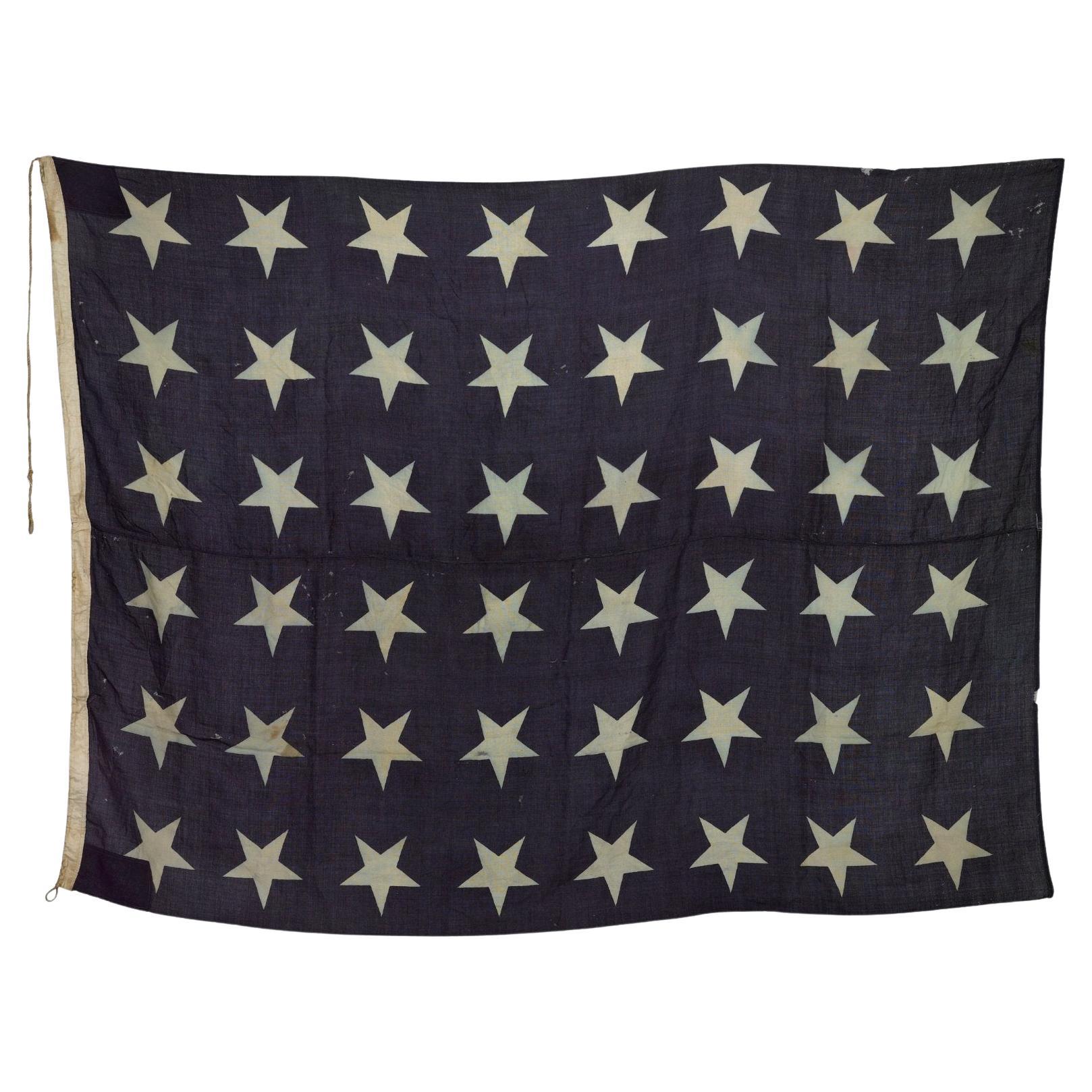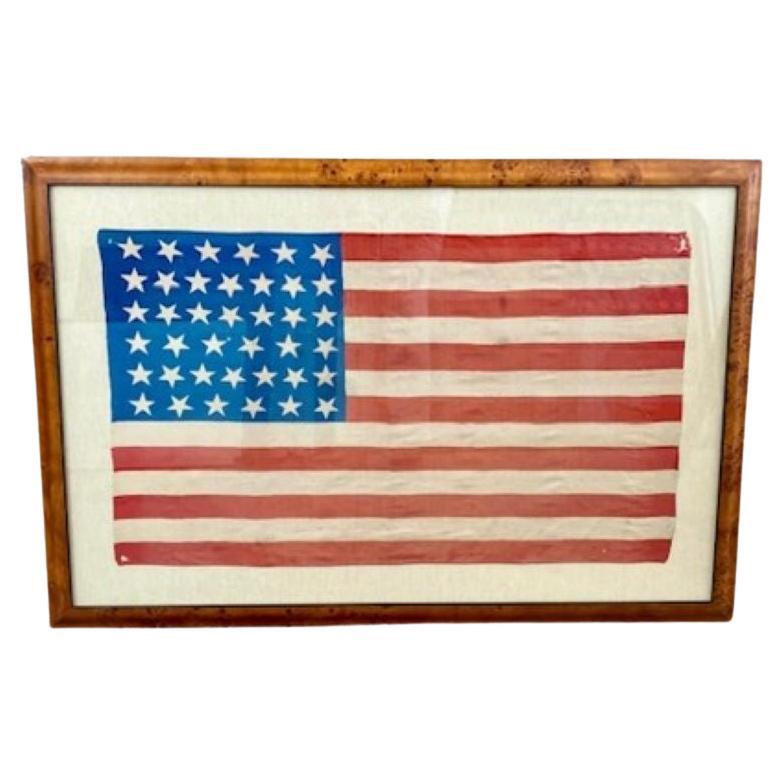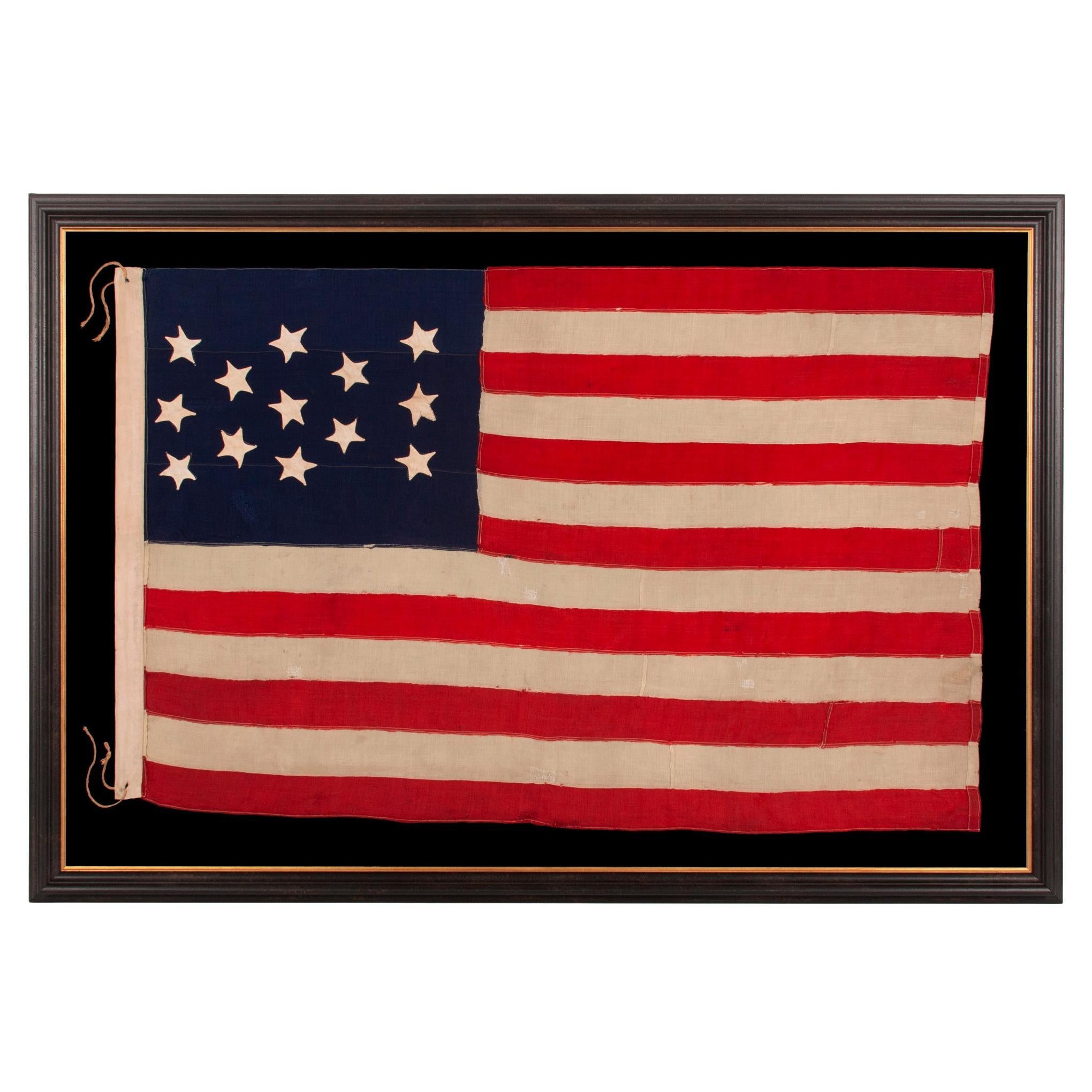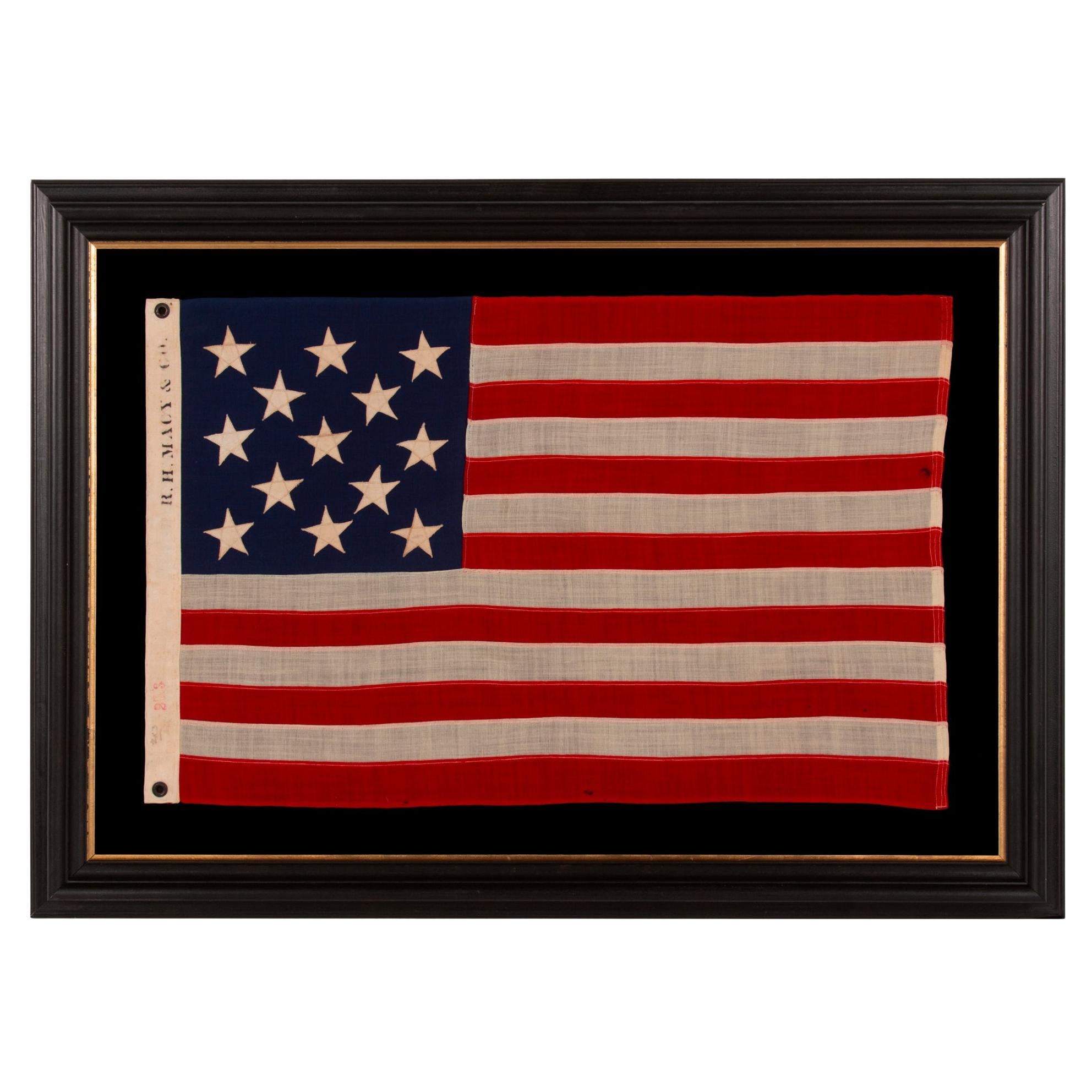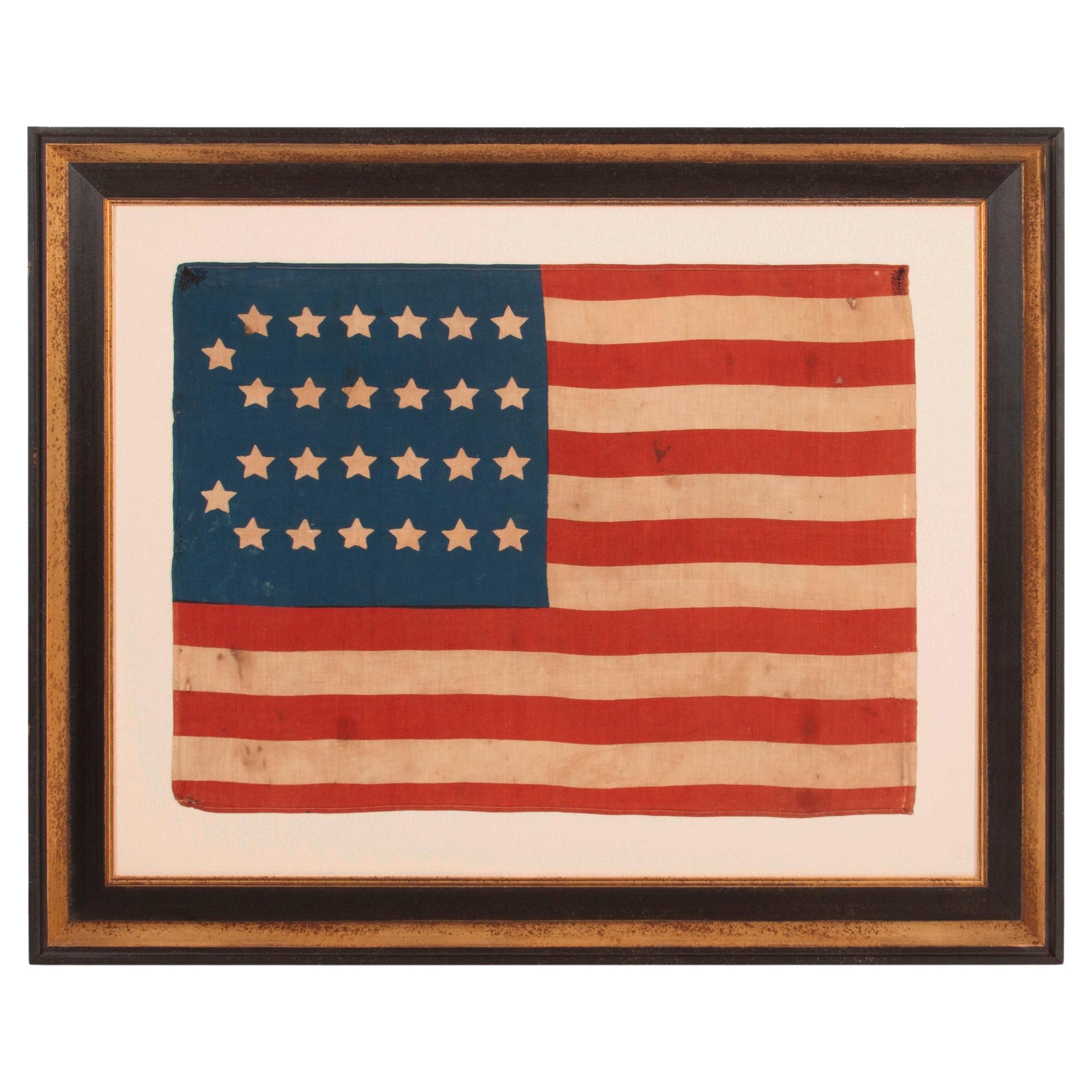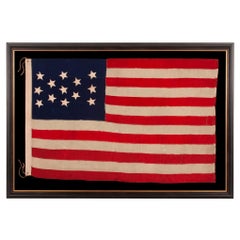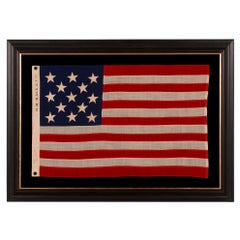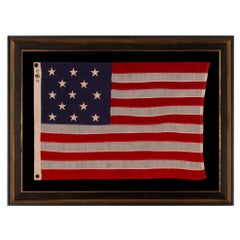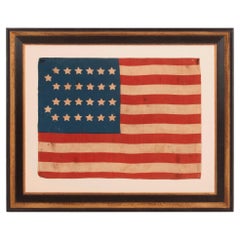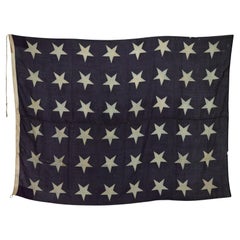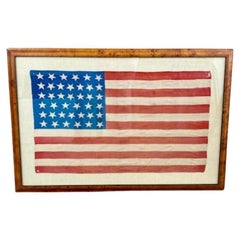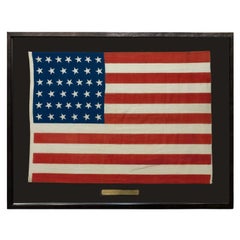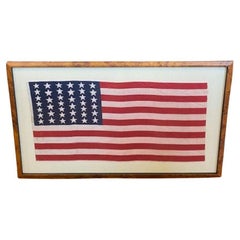Items Similar to 45 Star Antique American Naval Jack, ca 1896-1908
Want more images or videos?
Request additional images or videos from the seller
1 of 6
45 Star Antique American Naval Jack, ca 1896-1908
Price Upon Request
Price Upon Request
Price Upon Request
Price Upon Request
Price Upon Request
Price Upon Request
Price Upon Request
Price Upon Request
Price Upon Request
Price Upon Request
Shipping
Retrieving quote...The 1stDibs Promise:
Authenticity Guarantee,
Money-Back Guarantee,
24-Hour Cancellation
About the Item
LARGE & BEAUTIFULLY FADED, ANTIQUE AMERICAN JACK w/ 45 STARS ARRANGED IN A “NOTCHED” PATTERN, INTENTIONALLY LEAVING SPACE FOR THE 3 REMAINING WESTERN TERRITORIES YET TO BE ADDED; MADE IN THE PERIOD BETWEEN 1896 - 1908, WHEN UTAH WAS THE MOST RECENT STATE TO JOIN THE UNION; SPANISH-AMERICAN WAR ERA
Like the British Royal Navy, American vessels flew three flags. These included the American national flag, a Union Jack (not to be confused with the British Union Flag, often identified by this name), and a masthead or “narrow” pennant, commonly referred to today as ‘commission pennants.’
The American Navy jack, often simply referred to as the "jack," was to be comprised of a blue field with white stars. In terms of size, it was to be the mirror image of the canton of the corresponding Stars & Stripes ensign with which it was flown. When at anchor or moored, the jack is flown at the bow (front) and the national flag or "ensign" is flown at the stern (back), and the commission pennant is flown from the main mast. When under way, the jack is furled and the ensign may be kept in place or shifted to a gaff, if the ship is so equipped.
When Utah finally entered the Union as the 45th state on January 4th, 1896, it had been attempting to gain statehood for many years. It remained a territory primarily due to the fact that the Mormon Church and Utah authorities continued to be openly tolerant of polygamy. In 1890, Mormon Church President Wilford Woodruff published a manifesto that denounced the contract of “any marriages forbidden by the law of the land”. This gave way to Utah’s 1896 acceptance. The 45 star flag was generally used from that year until 1907, when Oklahoma joined the Union. Due to the Spanish-American War (1898) and Teddy Roosevelt’s famous world tour of the “White Fleet” (launched in 1907), this was an extremely patriotic period.
The stars of this particular jack are arranged in what we call a “notched” pattern. Evidence of the eagerness for new states is particular notable is this type of design, which in this case leaves three spaces open for the easy addition of Oklahoma, New Mexico, and Arizona. Earlier in the 19th century, the complement of territories, their names, borders, and potential for statehood were less certain. After the Dakota Territory entered as two separate states in 1889, the remainder of the path was easier to predict. For this reason, one will find 44 star flags with notches for 4 additional states, and 46 star flags with notches for 2, preceding the future count of 48 that was achieved in 1912. Notched arrangements appear in earlier flags, as well, but not with the correct number of spaces to reach a sum of 48 states in the continental union.
According to the Third Flag Act, passed by Congress on April 4, 1818, stars were to be added on Independence Day following a state's addition. Flag makers didn't generally care what was official, however, so while the 45 star count remained official until July 3rd, 1908, it would have generally fallen from use when Oklahoma gained statehood on November 16th, 1907.
Despite the fact that they were flown on all Navy ships, jacks with fewer than 48 stars are anything but common. Those with unusual star patterns of any sort are even less so. Surviving examples are extraordinarily scarce. At approximately 5.75 x 7 feet (plus the 1.5” hoist), this flag does not coincide with navy specifications. The navy generally made their own flags, though they did sometimes acquire commercial sources, especially during war time. The period of use of the 45 star flag did include the Spanish-American War, and sizes did vary, regardless of regulations, especially early-on. By the 45 star era, however, measurements seem to have been far more consistent and because the war last just one year, it did not necessitate the sort of prolonged demand and shortages that the Civil War or WWI and WWII required.
Because private ships often mirrored navy practice with regard to the use of signals, many senior captains being ex-navy, military ships were not the only ones flying jacks. Some flew them for practical purpose and others for show. One notable place they are recorded is in the photographs and paintings of Hudson River steamers. These were often dressed as debutants headed for a ball, with many colorful flags unfurled to impress both passengers and onlookers. They were also flown by yachtsmen. Due to the size of this flag, it would have accompanied an ensign that was probably between 19 and 22 feet in length on the fly, and so less likely to have belonged to a yacht, though not impossible.
The body of the flag is made of a wool and cotton blended fabric, identical to 100% wool bunting in its general appearance, that has been pieced and joined with machine stitching. Though I have seen this fabric before numerous times in the 1896-1908 era, it is nonetheless very unusual in this period, present in maybe 3 or so examples out of 100 of its counterparts with pieced-and sewn construction. If such flags were signed, I expect that they would all be easily identified to the same maker. Because I cannot recall having ever encountered this in a 44 star flag of any sort, nor in anything prior (43, 42, 41, 40, or 38 stars), I presume that this was an experimental fabric of the time. Inexperience with dying the blended fabric is probably what led to the bleeding of the color from this example, the consequences of which were its nonetheless beautiful presentation. Both this and the shade of indigo, leaning toward a sea-green, ocean blue, lend the impression of intentionally distressed denim. Flags such as this are few and far between. One almost couldn’t script a better look, and the best thing is that it is entirely legitimate.
The blue fabric was pieced from three lengths to achieve the desired height on the hoist. The stars of the flag are made of cotton and are double-appliqued with a lineal machine stitch. The latter is most commonly encountered in the 1890-1895 era. By 1896 most makers had transitioned to electric machines with a zigzag machine stitch to accomplish this task. There is a sailcloth binding along the hoist with two hand-sewn, whip-stitched grommets, sewn around metal rings for reinforcement. Note the single strand of blue filament, woven into the fabric by its maker, to assist with accurate trimming.
Mounting: The flag has been hand-stitched to 100% natural fabrics throughout for support. It was then hand-stitched to a background of hemp fabric, ivory in color. The mount was then placed in a black-painted and distressed Italian molding, with a wide, shaped profile, to which a rectangular molding with a textured, dark, gilded surface, was added as a liner. The glazing is U.V. protective Plexiglas.
Condition: There is significant dye loss / fading and there is some soiling. There are very minor holes throughout, accompanied by a few modest tears with associated loss, the most significant of which is a vertical area about the height of a star, near the fly end. Fabric was selected to place behind these areas during the mounting process to improve its appearance against the ivory ground. The flag had stretched a great deal along the hoist, likely due to inexperience with long-term use of the experimental fabric. I elected to strategically tuck the affected area under during the mounting process. Many of my clients prefer early flags to show their age and history of use.
Frame Size (H x L): 81.5" x 98.75"
Flag Size (H x L): 68.75" x 85.5"
- Dimensions:Height: 81.5 in (207.01 cm)Width: 98.75 in (250.83 cm)Depth: 2.5 in (6.35 cm)
- Materials and Techniques:
- Place of Origin:
- Period:
- Date of Manufacture:1896-1908
- Condition:See Item Description.
- Seller Location:York County, PA
- Reference Number:Seller: 45j-10121stDibs: LU849741177622
About the Seller
5.0
Recognized Seller
These prestigious sellers are industry leaders and represent the highest echelon for item quality and design.
Established in 1991
1stDibs seller since 2008
70 sales on 1stDibs
Typical response time: 1 to 2 days
- ShippingRetrieving quote...Shipping from: York County, PA
- Return Policy
Authenticity Guarantee
In the unlikely event there’s an issue with an item’s authenticity, contact us within 1 year for a full refund. DetailsMoney-Back Guarantee
If your item is not as described, is damaged in transit, or does not arrive, contact us within 7 days for a full refund. Details24-Hour Cancellation
You have a 24-hour grace period in which to reconsider your purchase, with no questions asked.Vetted Professional Sellers
Our world-class sellers must adhere to strict standards for service and quality, maintaining the integrity of our listings.Price-Match Guarantee
If you find that a seller listed the same item for a lower price elsewhere, we’ll match it.Trusted Global Delivery
Our best-in-class carrier network provides specialized shipping options worldwide, including custom delivery.More From This Seller
View All13 Star Antique American Flag with a Narrow Star Presentation, ca 1876
Located in York County, PA
13 STAR ANTIQUE AMERICAN FLAG WITH HAND-SEWN STARS IN AN EXTREMELY NARROW PRESENTATION OF A 3-2-3-2-3 ARRANGEMENT ON A CANTON THAT DOESN’T FOLLOW SUIT, LEAVING WIDE EXPANSES OF BLUE ...
Category
Antique 1870s American Political and Patriotic Memorabilia
Materials
Wool
Price Upon Request
13 Star Antique American Flag, Marked "R.H Macy & Co", circa 1895-1926
Located in York County, PA
13 STAR ANTIQUE AMERICAN FLAG WITH A 3-2-3-2-3 CONFIGURATION OF STARS; A SMALL-SCALE EXAMPLE, MADE IN THE 1895-1926 ERA, MARKED “R.H. MACY & CO.”
13 star antique American flag of th...
Category
Antique Late 19th Century American Political and Patriotic Memorabilia
Materials
Wool
Price Upon Request
13 Star Antique American Flag, Inscribed "Spenge" ca 1895-1926
Located in York County, PA
13 STAR ANTIQUE AMERICAN FLAG WITH A 3-2-3-2-3 CONFIGURATION OF STARS ON AN ATTRACTIVE, INDIGO BLUE CANTON; A SMALL-SCALE EXAMPLE OF THE 1895-1926 ERA, INSCRIBED WITH THE SURNAME “SP...
Category
Antique Late 19th Century American Political and Patriotic Memorabilia
Materials
Wool
26 Star Antique American Flag, with 11 Stripes, Michigan Statehood, ca 1837-1846
Located in York County, PA
26 STAR ANTIQUE AMERICAN PARADE FLAG WITH 11 STRIPES AND IT’S CANTON RESTING ON THE “WAR STRIPE.” THE EARLIEST KNOWN STAR COUNT FOR PRINTED EXAMPLES, 1837-1846, MICHIGAN STATEHOOD
2...
Category
Antique Mid-19th Century American Political and Patriotic Memorabilia
Materials
Cotton
36 Star Antique American Parade Flag, with Canted Stars, ca 1864-1867
Located in York County, PA
36 STAR ANTIQUE AMERICAN PARADE FLAG WITH CANTED STARS IN DANCING ROWS, ON A BEAUTIFUL, CORNFLOWER BLUE CANTON; CIVIL WAR ERA, NEVADA STATEHOOD, 1864-1867
36 star antique American f...
Category
Antique 1860s American Political and Patriotic Memorabilia
Materials
Cotton
Price Upon Request
42 Hand Sewn Stars on An Antique American Flag ca 1889-1890
Located in York County, PA
42 HAND-SEWN STARS ON AN ANTIQUE AMERICAN FLAG WITH A TWO-TONE, DUSTY BLUE CANTON, REFLECTS THE ADDITION OF WASHINGTON STATE, MONTANA, AND THE DAKOTAS, NEVER AN OFFICIAL STAR COUNT, ...
Category
Antique Late 19th Century American Political and Patriotic Memorabilia
Materials
Wool
Price Upon Request
You May Also Like
48-Star American Naval Jack Flag
Located in Colorado Springs, CO
Presented is a large 48-star American Naval Jack. This impressive wool flag features a rich navy flag with a field of 48 white stars. The stars are arranged in six rows of eight star...
Category
20th Century American Nautical Objects
Materials
Wool, Rope
19th Century American 39 Star Flag, circa 1889
Located in Nantucket, MA
19th Century American 39 Star Flag, circa 1889, a period printed silk parade flag with a wavy pattern of dancing stars. This was never an official flag of the United States but was m...
Category
Antique 1880s American Federal Political and Patriotic Memorabilia
Materials
Silk
39-Star Antique American Flag with 'Whimsical' Star Pattern, 1889
Located in Colorado Springs, CO
This is a 39-star unofficial American flag, handmade and printed on cotton. The flag dates to 1889 and has a unique history, thanks to its rare star-count.
The flag’s canton is prin...
Category
Antique 1880s American Political and Patriotic Memorabilia
Materials
Cotton
19th Century 39 Star American Flag, circa 1889
Located in Nantucket, MA
19th Century 39 Star American Flag, circa 1889, a printed linen ensign with 39 stars arranged in a wavy star pattern, with stripes in a very unus...
Category
Antique 1880s American Federal Political and Patriotic Memorabilia
Materials
Linen
31-Star Printed American Flag, Celebrating California Statehood, Circa 1850
Located in Colorado Springs, CO
This is a rare 31-star medallion printed American flag, celebrating the addition of California to the Union. The flag is printed on silk and has a spectacular “Great Star” canton pat...
Category
Antique 1850s American Political and Patriotic Memorabilia
Materials
Silk
38-Star Antique American Flag with Unique Canton, circa 1876-1890
Located in Colorado Springs, CO
This is a striking 38-star American flag. The flag dates to 1876-1890, when Colorado (represented by the large star in the center of the flag’s canton) joined the Union as the 38th s...
Category
Antique Late 19th Century American Political and Patriotic Memorabilia
Materials
Muslin
More Ways To Browse
Civil War Antiques
Black Memorabilia
Naval Furniture
Naval Ship
Antique Jacks
Folk Art Church
Antique Metal Star
19th Century American Flag
Royal Flag
Dior New Look Dress
British Royal Navy
Royal Memorabilia
Antique Wool Machine
Antique American Flag Framed
Space Memorabilia
Navy Flags
Naval Antiques
Antique Metal Records
